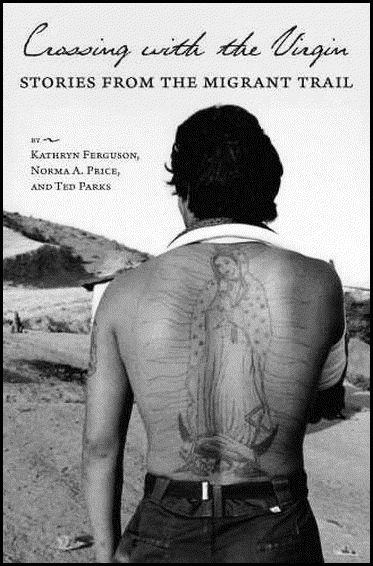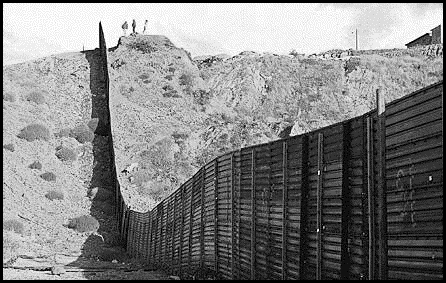Stories from the Migrant Trail
Kathryn Ferguson, Norma A. Price, Ted Parks
(University of Arizona Press)

One of these organizations is known as "The Samaritans;" another, "No More Deaths." They are there to try to reduce the number of Mexicans dying in one of the least human-friendly places on earth, the Sonoran Desert. Crossing with the Virgin is a report from the trenches: three volunteers recounting their days (and nights) looking for "illegals" in need.
These volunteers drive through the desert and wander up and down hidden trails seeking out people who are often trying to hide from them (they think that they may be working for the "migra" --- the INS). The Samaritans and No More Deaths volunteers offer water and food, and, if necessary, medical help.
They stop at strategic places and call out, "Somos amigos." We're friends. "Hay agua ... hay comida." We have water and food. They also leave caches of water with flags so they can be spotted from afar.
There are the obvious problems they find of those who have struggled through the desert for days. They are suffering from heat stroke, dehydration, hypothermia, rattle-snake bites ... and blisters, terrible blisters on their feet.
And there are the body traumas. Running and falling when the INS appears. People dazed by the heat or the cold. Children and the very old in extremis.
And dying. The admittedly conservative figures of the INS report that 1,954 people died crossing the U.S - Mexico border between the years 1998 - 2004. The figures are more likely somewhere between 300 - 500 a year now but no one knows for sure. Those who are familiar with the mountains and desert crossing areas report finding skeletal remains in the arroyos. A report in the Arizona Daily Star observed, "The number of dead border-crossing migrants per year in Arizona increased from nine in 1990 to 201 in 2005; about 80% of the dead migrants were under 40 during 2000-2005, with an increasing number younger than 18."
"The children you see crossing tug at your heart," writes one of the three authors here. "The children who die break your heart."
- Just months ago a three-year-old child died of dehydration while crossing the Tohono O'odham Nation. The young mother was trying to reach her husband in California.
"Unsympathetic authorities considered charging the mother with child abuse."

And sometimes --- ¡ay carramba! --- the Samaritans inadvertently make it so that the border-crossers are captured. When the volunteers stop their cars to help those hiding in gullies, in culverts, in mountainous areas, the INS may not be far behind.
In one of the stories here, Samaritans have come to offer help to "illegals" hiding under a bridge ... and the INS appears. When the Mexicans start to run, the agent calls for "backup" and, according to the writer, "the prey has no chance ... There is more Border Patrol backup than there are stars in the sky."
- Second only to dollars poured into Iraq and Afghanistan, Homeland Security receives more funding than any other U. S. agency.
For centuries our border was porous: Mexican nationals came across, worked, and then went home. But, after 9/11, Congress decided that Mexican workers were a danger to our national security. A wall is in the process of being built to keep out the interlopers.
According to the Washington Post, Homeland Security has spent "$3.4 billion on border fencing in recent years, completing 640 of a planned 652 miles of fencing and vehicle barriers as part of the Secure Border Initiative. Last year, DHS officials predicted it would cost $6.7 billion to secure the full border, minus a 200-mile span in southwestern Texas that is difficult to cross and expensive to monitor."
A wall, growing like a cancer, on our south-west border, because those in power don't remember what happened to its prototype: the Berlin Wall. It lasted for thirty-five years and then it fell, partly because it was an ugly symbol of power fanged with hate and hubris. Its collapse spread joy around the free world. Our Terror-Madness may outlive our own Berlin Wall.
The thirty-nine stories may well touch the reader deeply, but not all address chases and falls and dying of dehydration. The INS agents often save lives. The indian Tohono O'odham Nation, on the other hand, may not. They are owners of vast stretches of desert in the far south of Arizona ... and so far have refused the Samaritans permission to erect reservoirs of water for the border-crossers.
A friend of mine works with No More Deaths as a volunteer. She reports that the tragedy is well reflected in the courtroom of what they call "Operation Streamline."
This is a fast-track system that chains undocumented border-crossers together, brings them to court, has them declared guilty en masse, and then deports them. Even one of the Magistrates was, my friend tells me, brought to tears by one of the sights before her: Mexicans shackled and hustled through the courtroom and quickly boarded (still in shackles) into trucks and busses to be taken back to the Mexican side of the desert. It was agonizing for her to see men, often older men, still in their sweat-stained shirts and pants, crowded before her, unable, due to their shackles, to touch their own faces ... in a few cases, to wipe away tears.
It was just too much for her. As it should be for all of us.
